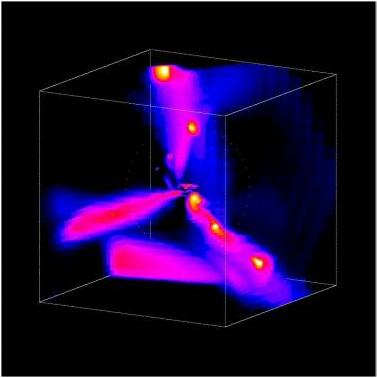The galaxies are composed into two major types: spiral and elliptical. The spiral galaxies, such as our Milky Way, are rotating disks, rich in hydrogen gas, and are constantly forming new stars. The young stars give the spiral galaxies a blue tint. In contrast, the elliptical galaxies have bodies with a larger, more rounded shape, and are made of old, red stars that are devoid of gas. They are therefore referred to as red and dead.
The attempt to understand the way in which these two types of galaxies form is the primarily challenge facing modern cosmological researchers. The formation of galaxies is an essential stage in the cosmological process that leads to the formation of life.
A new theory as to how galaxies were formed in the Universe billions of years ago has been formulated by Hebrew University of Jerusalem cosmologists and it takes issue with the prevailing view on how the galaxies came to exist.

New theory: Computer simulation of galaxy formation shows matter flowing into the center of a galaxy through three cold gas streams. Credit: The Hebrew University of Jerusalem
The new theory says that the galaxies primarily formed as a result of intensive cosmic streams of cold gas (mostly hydrogen) and not, as current theory contends, due primarily to galactic mergers. The researchers say that these mergers had only limited influence on the cosmological makeup of the universe as we know it.
The results of the cosmology research group, led by Prof. Avishai Dekel, who holds the Andre Aisenstadt Chair of Theoretical Physics at the Racah Institute of Physics of the Hebrew University, appear in Nature.
The accepted model until now has as its basis the idea of spherical gas infall into a central disk, followed by mergers between disks. The assumption is that the stars formed slowly within the gaseous disks, and that the disks converted into globes when they merged. In such a merger, the colliding gas clouds produce a big burst of new stars at a rate of hundreds of solar masses per year.
This model has lately been put to question as a result of astronomical observations using new and more powerful telescopes which enable observations at greater depth into the Universe, making it possible thus to examine what happened in the galaxies some ten billion years ago (about three billion years after the Big Bang which first established the Universe). "The large galaxies, as they appear in this early stage, indeed created stars at a very rapid rate, but this does not appear to be at all a result of galactic mergers," says Prof. Dekel. The astronomical observations were led by researchers in Garching, Germany, headed by Prof. Reinhard Genzel of the Max Planck Institute, whose group is collaborating with the Hebrew University researchers.
The question that emerged was how these galaxies were able to form stars so quickly and in large quantities at such an early stage without massive galactic mergers.
In the article published in Nature, Prof. Dekel and his Hebrew University and French associates, pose their new theoretical model, which explains these observed phenomena. Their findings are based on computer simulations carried out by the French researchers headed by Prof. Romain Teyssier. The simulations, using one of the most powerful supercomputers in Europe, made it possible in an unprecedented manner to carry out a detailed investigation of how galaxies formed in the early Universe.
The picture that emerges is of galaxy-building that results from a continuous flow of cold gas along a few narrow streams rather than by mergers. These gas streams follow the filaments of the "cosmic web" that defines the large-scale structure of matter in the Universe, filaments that feed the dark-matter halos in the first place. These cold gas streams penetrate through the dark-matter halo of each galaxy and the hot gas that fills it and reach the center, where they become a rotating disk. These disks, each subject to its own, local, gravitational forces, break into a few giant clumps in which the gas converts into stars very efficiently.
By their calculations, Dekel and his group say that the rate of star formation, as predicted by this theory, is compatible with the observed rate. The researchers refer to these massive star formers in the early universe as Stream-Fed Galaxies (SFG). The galaxy merger phenomenon, in this view, was not the primary factor as maintained in current theory.
Prof. Dekel and his Hebrew University associates, Prof. Re'em Sari and Dr. Daniel Ceverino, worked out a simple physical theory that explains the formation of giant clumps in the early massive disks, and how they are driven by the cosmic streams. They predict that the migration of these clumps to the disk centers led to the formation of elliptical galaxies already in the early Universe, independent of galaxy mergers. They are thus making the revolutionary proposal that the role of cosmic gas streams is not limited only to the formation of star-forming disks, but that these streams are also responsible for the subsequent formation of the red-and-dead elliptical galaxies.




Comments